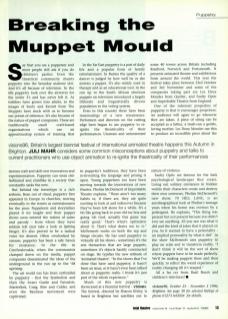Say that you are a puppeteer and most people still ask if you do children's parties. Even the theatrical community shunts puppetry into the Saturday matinee slot. And it's all because of television. In the 60s puppetry took over the airwaves for the under 5s and has never left it. As toddlers have grown into adults, so the images of Sooty and Kermit from The Muppets have stuck with us to become our points of reference. It's also because of the nature of puppet companies. These are traditionally small craft-based organisations which use an apprenticeship system of training that stresses craft and skill over innovation and experimentation. Puppetry can seem old fashioned and childlike in a society that constantly seeks the new.
But behind the stereotype is a rich artform. Born out of ritual, puppetry first appeared in Europe in churches, moving eventually to the streets as entertainment for the poor. Puppeteers and storytellers played it for laughs and their puppet shows soon entered the realms of satire and parody – areas which they have seldom left (just take a look at Spitting Image). It's also proved to be a radical voice for dissent. Often overlooked by censors, puppetry has been a safe haven for resistance. In the 60s in Czechoslovakia, when the communists clamped down on the media, puppet companies disseminated the ideas of the underground in the run up to the '68 uprising.
The art world too has been enthralled by puppetry – first the Symbolists and then the Avant Garde and Futurists. Maeterlink, Craig, Klee and Calder, and even the Bauhaus movement were captivated.
In the Far East puppetry is a part of daily life and a popular form of family entertainment. In Burma the quality of a dancer is judged by how well he or she mimics a puppet. It's also widely used in therapy and as an educational tool. In the run up to the South African elections puppets on television introduced a largely illiterate and linguistically diverse population to the voting system.
Even in this country there have been murmurings of a new renaissance, Performers and directors on the cutting edge have begun to use puppetry to reignite the theatricality of their performances. Unaware and uninterested in puppetry's traditions, they have been reinventing the language and prising it open. Young puppeteers too have been moving towards the innovations of new theatre. Phelim McDermott of Improbable Theatre explains, ‘There aren't too many habits or, if there are, they are quite exciting to look at and rediscover because they've been left alone for a while. It's a bit like going back to your old toy box and going “oh God, actually this game was really good”. That's what's optimistic about it. That's what draws me to it.’ McDermott works on both the rep and fringe circuits. He has used puppetry in virtually all his shows – sometimes it's the sets themselves that are large puppets, sometimes it's objects hastily constructed on stage. He typifies the new attitude of 'animated theatre'. ‘In the shows that I've done that have used puppetry, it hasn't been an issue, or it hasn't even been talked about as puppetry really. I think it's just part of the whole experience.’
Much of this new puppetry is showcased at a biennial festival – visions. The festival, directed by Sharon Kivity, is based in Brighton but satellites out to some 40 towns across Britain including Bradford, Norwich and Portsmouth. It presents animated theatre and exhibitions from around the world. This year the festival takes place between 23 October and 3 November and some of the companies taking part are Les Deux Mondes from Quebec, and Faulty Optic and Improbable Theatre from England.
One of the inherent properties of puppetry is that it encourages projection. An audience will agree to go wherever they are taken. A piece of string can be accepted as a father, a trash-can a gentle, loving mother. Les Deux Mondes use this to produce an incredible piece about the nature of violence.
Faulty Optic are famous for the dark psychological landscapes they create. Living out solitary existences in hidden worlds their characters create and destroy their own universes. Phelim McDermott's new show, 70 Hill Lane, is an autobiographical look at Phelim's teenage years when his home was overrun by a poltergeist. He explains, ‘This thing was present but not present because you didn't ever see anything. All you saw was what it did and the kind of jokes that it played on you. So it seemed to have a personality – an implied personality by what it did.’ In the show McDermott uses puppetry to play on scale and to transform reality. ‘I don't think it will be the sort of show where puppets have to be made perfectly. We'll be making puppets there and then quickly, to reflect the weird experience of reality changing till it's warped.’
All a far cry from Basil Brush and children's television!

